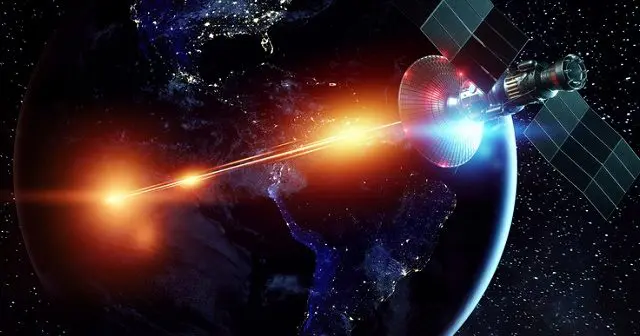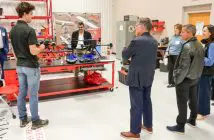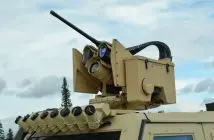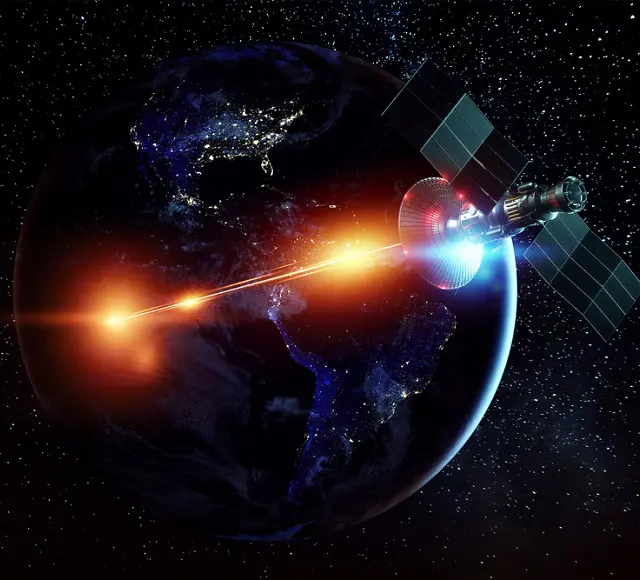
INTRODUCTION
Transition to a soldier armed with a Laser Weapon Device will be the next Technology Shock in conventional warfare, leading to new tactics and battle strategies. A future battle will likely have three intermeshing components: (1) Epicentre Battle fought on the Terrestrial Surface, likely to operate strategically on the offensive, but tactically on the defence; (2) Space-Based War (where Hypersonic and Space-Based Weapons are likely to provide strategic weapons strikes); and, (3) Peripheral Marauder Battle. The focus of this short overview paper will be the Terrestrial Surface Battlefield, which is anticipated to be a more defensive-style of battle, and will see transition from one dominated by conventional kinetic weapons: small arms (personal firearm weapons), machine guns, and artillery types, to one dominated by missiles, and weapons based on converting input energy into output energy: Lasers. A Laser’s near-straight trajectory, and range limitation determined by its point of diminishment (through Beam Divergence), represent a major shift in battlefield geometry based on straight-lines.
This paper will explore tactical notions such as Laser Screens, Urban saturation of fast-to-plug-in Laser Weapon Devices, a deep-penetration varied effects tactic, and the rising domestic threat posed by Homemade Laser Pistols.
This paper will look at the implications of Laser Weapon Devices (mainly referring to Directed Energy Weapon: High Energy Laser technology), in terms of: (1) Historic shift to Laser Weapon Devices; (2) Technology characteristics of a Laser, in terms of its Range, Trajectory, Effect Limitations and Dwell-Time; and, (3) How Laser technology characteristics frame strategic-tactical concepts on a largely changed battlefield.
- HISTORIC SHIFT TO LASER WEAPON DEVICES
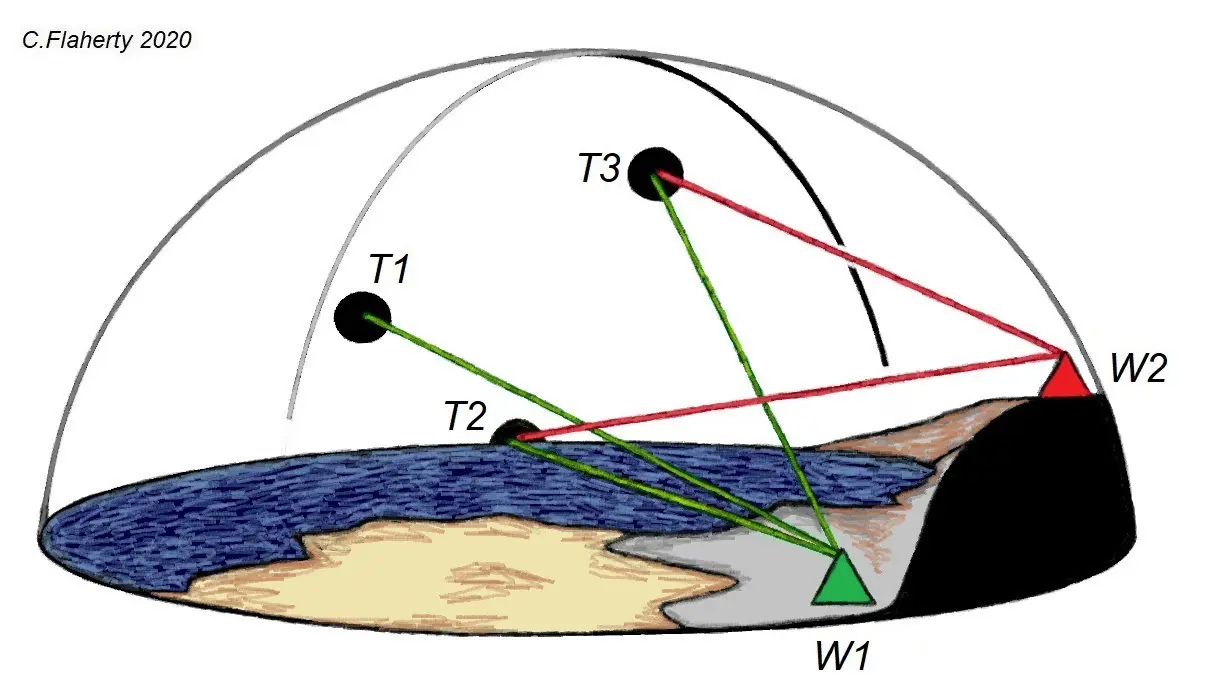
“FIGURE 1: Illustrates two Laser Weapon Devices (W1-2), engaging three Targets (T1-3).”
Currently, several proprietary technologies are being developed, are in the test-demonstrator stage, and ultimately one or more will become the basis of a future generation of Close-In and Battlefield Laser Weapon Devices; that will begin a process to replace conventional kinetic weapons. It is now generally considered that:
“we have suddenly arrived in an era where Laser weapons will become widespread across the battlefield” (Rogoway, 2020).
However, at the current stage of use, Lasers represent a, “novel force protection and precision-strike … [option]” (Spencer, 2020).
The U.S. in-service (2014 till present) Laser Weapon System (LaWS), can shoot down Unmanned Aerial Vehicles at shorter ranges and blind the sensors at longer ranges (Team Crane, 2012). It was recently installed on the USS Ponce AFSB(I)-15, from 2014 till 2017 (Dukowitz, 2017). A solid-state laser Weapon System Demonstrator with a power level of 150 kilowatt (Freedberg, 2020), is currently fitted to the USS Portland LPD-27 (Commander, 2020). A Lockheed Martin version (2018 till present) Laser Weapon System is fitted to the USS Arleigh Burke DDG-51 (Laporta, 2018).
The Russian Peresvet Laser (2018 till present) has a largely anti-satellite role designed to conceal the movements of road-mobile Intercontinental Ballistic Missiles by temporarily affecting imaging capabilities, dazzling or permanently blinding optical systems of enemy reconnaissance satellites while passing over (Hendrickx, 2020). Located close to the Targets they are intended to protect, four current Peresvet Laser home bases are known: Unit 2146/1 with the 54th Missile Division (near Teykovo); Unit 2146/2 (39th Missile Division near Novosibirsk); Unit 2146/3 (35th Missile Division near Barnaul); and, Unit 2146/5 (14th Missile Division near Yoshkar-Ola).
Nominally called the Laser Battalion, to be stood-up in 2021, and a regiment of four battalions by 2023, the U.S. Army Space and Missile Defense Command will operate Directed Energy-Maneuver Short-Range Air Defense Stryker combat vehicles (Keller, 2020). The Laser system will be integrated into the vehicle’s existing hardware. Intended to be used to defend against Unmanned Aerial Vehicles and incoming artillery rockets. A heavier truck version carrying a system that could potentially channel enough power to counter incoming cruise missiles is also planned for the Laser Battalion.
Current Laser Weapon Devices are largely thought about in terms of characteristics classified by their proprietary technology, and novel uses. However, the transition from conventional kinetic weapons to Laser Weapon Devices will start a shift in thinking towards looking at the relationship between technology characteristics, how these translate into function-task equivalence, and the strategic-tactical concepts underpinning their use (Preston, 2002).
FIGURE 1: Illustrates several scenarios showing Laser Weapon Devices attacking various Targets. Fundamentally, the tactics are determined by four factors: (1) Lasers can fire at various levels of intensity; (2) are range-limited; (3) travel in a straight-line; and (4) require height to extend the direct line-of-sight range over the curvature of the Earth’s surface. Laser Weapon Device (W1): Engages Targets (T1-3) with Cold (Green) Laser disrupting electronics and dazzling optics. Laser Weapon Device (W2): Engages Targets (T2-3) with Hot (Red) Laser burning through the vehicle skin causing catastrophic damage. Target (T2) is partially hidden by the curvature of the Earth’s surface. Laser Weapon Device (W1) has only limited line-of-sight, whereas Laser Weapon Device (W2) located higher has a greater line-of-sight view of the Target (T2).
- GENERIC LASER WEAPON DEVICE CHARACTERISTICS
Fundamentally, a Laser Weapon Device is a system that converts one form of energy (electrical, chemical, electromagnetic) into a concentrated Beam of another type of processed energy at a particular frequency and power level (Spencer, 2020; see FIGURE 2). Currently, Laser Weapon Devices are linked not so much to a weapon’s class (or its task-function), but a specific novel threat, such as needed to deal with an emerging threat from swarm Unmanned Aerial Vehicle attacks, which have small radar cross sections and fly at slow speeds, or small high-speed boats (Team Crane, 2012).
A key characterisation problem currently is that several function-task related definitions exist for a Laser Weapon Device. For instance, “causing material damage.” (Spencer, 2020) There is also a U.S. damage ratings scale (Department of Defense; Tatum, 2017; Spencer, 2020), that identifies a top register LEVEL 5: PERMANENT DAMAGE, as:
| 5 | Catastrophic and permanent effect until repaired. | Target functioning is disrupted and requires hardware, software, or firmware replacement to repair and restore functionality. |
The U.S. ratings scale that categorises and defines different levels of Laser damage effects, is not widely accepted as a common standard reference (Spencer, 2020). Nevertheless, it is important to move from classifications based on proprietary technology (discussed earlier), and unique scenarios. It is also largely the case, that current Laser technology can produce a device that can vary its Beam intensity range from temporary non-damaging effects upwards to higher intensities that burn-through a Target (Spencer, 2020). The unique capability to change settings so to speak also creates a weapons class that has a dynamic operating scope, which will effect its strategic-tactical uses, as it will create potential for new types of tactics, and battle strategies.
TABLE 1: Looks at the comparison between High and Low Energy Laser, Targets and Typical Effects. A Laser Weapon Device might use a Low Energy Beam to only dazzle a human observer or disrupt an electro-optic sensor, and use a High Energy intensity Beam output option to destroy material targets (Spencer, 2020).
| Theoretically, the same Laser Weapon Device could operate on several different settings, giving a spectrum of dynamic responses to a Target (discussed later looking at the deep-penetration varied effects tactic). | TABLE 1: Comparison Between High and Low Energy Laser, Target and Typical Effects. | ||
| TYPE | TARGET | TYPICAL EFFECT | |
| HIGH ENERGY LASER | Aircraft/helicopter canopy | Fogging/flash | |
| Thin-skinned vehicles | Burn-through | ||
| Optics | Crazing/cracking | ||
| LOW ENERGY LASER | Optical sensors | Saturation | |
| Missile seeker | Detector burnout | ||
| Bio-optics |
| ||
Source: U.S. Army, 1992; Spencer, 2020.
Power Supply Question
A Laser Weapon Device could have its own power supply (see FIGURE 2), or it could foreseeably draw its power from any universal source. Notionally, countries are increasingly dependent on a Common Shared Platform: a shared logistical base providing among other services power generation and distribution (this is discussed later looking at new strategic-tactical concepts). Access to universal power, factors into a fundamental logistics question arising in relation to Laser Weapon Device use, namely its Deep Magazine Capacity,
“to produce a relatively unlimited number of Laser shots unconstrained by the time and mechanical forces needed to store, reload and consume magazine ammunition.” (Spencer, 2020)
Compared to conventional kinetic weapons, logistics, expended rounds, ancillary and consumable parts costs are significantly reduced for Laser Weapon Devices (Spencer, 2020). Magazine depth is limited only by the capacity of the power supply; the major exception being the chemical fuel High Energy Laser – these are more limited since their magazines rely on the availability of stores of Laser-enabling chemical agents which are consumed in the Laser firing process (Spencer, 2020).
A shift towards Laser Weapon Devices as the Close-In and Battlefield Weapon could see a future generation of a fast-to-plug-in version. It could be mass-produced through a technological convergence of 3D-Printing technology, using designs down loadable anywhere in the world (this topic is discussed later in this paper). It could be designed to access a myriad of mixed local power sources, much like cheap to set-up Laser ground-links are being used in many developing countries to achieve access to communication satellites.

“FIGURE 2: Generic Design Model for a Laser Weapon Device.”
Source: Vetrovec, 2002; Spencer, 2020; Various Sources (Author’s Analysis).
FIGURE 2: Illustrates a fundamental design for a notional Laser Weapon Device (Spencer, 2020). This incorporates elements of a proprietary technology Solid-State High Energy Laser design (Vetrovec, 2002).
As stated, there are currently several proprietary technologies being developed, and are in the test-demonstrator stage, and ultimately one or more of these will become the basis of a future generation of Close-In and Battlefield Laser Weapon Devices. This paper will look at three technology characteristics: (1) Range; (2) Trajectory; and, (3) Effect Limitations and Dwell-Time. The object will be to look at how these technology characteristics translate into strategic-tactical concepts (discussed at the end of this paper).
2.1 RANGE
As a general rule, a Laser in clear air or the vacuum of Space where nothing can interact with the light energy, the energy and momentum are conserved and can potentially travel forever (Spencer, 2020). That rule is qualified where atmospheric effects: weather conditions are considered, such as aerosols, particulates, or obscurants in the air – such as, water vapour, smoke, dust, then the Laser energy will interact with this matter and lose energy by transferring it to these objects, reducing the effectiveness of the Laser as a consequence (Spencer, 2020).
In broad terms, while Lasers carry in straight-lines (discussed next), these do not remain a tight Beam,
“the intensity of the Laser emission is slowly dissipated over distance owing to Beam divergence, reducing the density of the energy over a specified area with increasing distance away from the emitter … the Beamwidth will slowly spread over increasing distance away from the optical aperture, reducing the density of the energy per area.” (Spencer, 2020)
As a general rule: Beams naturally diverge over distance, leading to increasing Beamwidth as the distance away from the device (creating the Beam) increases (Spencer, 2020). Atmospheric effects largely also effect Beam divergence. Turbulence is another phenomenon that can cause the air over long-distances to act as a refracting lens, resulting in diffusion and distortion of the Beam, degrading its energy and performance (Spencer, 2020).
| TABLE 2: Shows that over a distance, a Beam will diverge based on the current technology limits. | TABLE 2: Beam Divergence and Target Distance. | |||
| DISTANCE | BEAM DIVERGENCE | |||
| 1,000 meters | 3,280.8 feet | 0.25 meters | 9.8 inches | |
| 5,000 meters | 3.1 miles | 1.25 meters | 49.2 inches | |
| 10,000 meters | 6.2 miles | 2.50 meters | 98.4 inches | |
Source: Spencer, 2020.
Current estimates for effective range of Solid-State and Fiber-Lasers are approximately 10 kilometres (10,000 meters): 6.2 miles, which likely gives a Bean Divergence of 2.50 meters: 98.4 inches; and at 100 kilometres: 62.1 miles for Chemical Lasers (Ellis, 2015; Spencer, 2020). It is generally understood current U.S. Navy in-service Laser Weapon System (LaWS) have effective ranges of 1 mile: 1.6 km: 0.87 nautical miles (Team Crane, 2012).
2.2 TRAJECTORY
Generally, unlike conventional ballistic and flying weapons a Laser’s Beam Trajectory is not affected by gravity, motion forces, kinematics, and aerodynamic effects (Spencer, 2020). Three basic rules apply to a Laser Beam Trajectory: (1) Its directed energy can propagate further and more easily in the vacuum of Space; (2) A Beam can reach a Target nearly instantly; and, (3) The Beam range limitation is only determined by its point of diminishment: through Beam Divergence. In general terms:
“Laser light is different from normal light in that it can be controlled and projected as a train of pulses or a continuous wave of energy, all with the same wavelength. A Laser naturally remains coherent and tightly focused Beam, even when projected over vast distances.” (Spencer, 2020)
2.3 DWELL-TIME AND EFFECT LIMITATIONS
A Laser to be effective requires an uninterrupted Beam to accumulate a level of energy at the Target to adequately cause the desired level of damage (Spencer, 2020). The key tactical issue is motion stabilisation of the Laser Weapon Device (while firing), in order that the Bean remains uninterrupted, and there is sufficient energy build-up, heating up a small spot area on its surface: the Dwell-Time. Two tactical variables, both potentially unknowns, are: (1) Intensity (quantity) of energy needed to damage a Target; and, (2) Time needed to achieve this. These factors depend on several extenuating circumstances, namely:
“the time required to damage a Target may be different in every engagement situation due to variations in … [its vulnerability, aspect, manoeuvring, and environmental conditions]” (Spencer, 2020).
Thermal properties reduce the Dwell-Time i.e. it is made from a combustible material, readily heats up and catastrophically fails, and only requires a short duration to be effected. Alternatively, in the case of Hypersonic Vehicles and re-entering Inter-Continental Ballistic Missile warheads these are, “purpose-designed to survive and function normally in extreme temperatures.” (Spencer, 2020) It is also been anticipated that the thermal protection system seen used in Hypersonic Glide Vehicle design, may inherently harden the missile’s outer skin, and may well outlast the Dwell-Time required to burn-through or sufficiently degrade the thermal protection skin of the vehicle before it can strike its Target (Speier, 2017).
A current technology limitation is keeping a Laser focused on the same location to cause damage and destruction, on a Target while it is moving, such as a flying craft. As a general rule, a Laser can engage targets at light speeds, the effects on the Target are typically not instantaneous and require some Dwell-Time. Factors such as surface airflow and windchill might dissipate the energy arriving at the Target sufficiently to delay the accumulation of energy needed to cause the desired level of damage (Spencer, 2020).
- THE NEW BATTLEFIELD GEOMETRY
The Byzantine sixth century mathematician Anthemius of Tralles (Knorr, 1983), a later twelfth century author (Tzetzes), and later artistic rendering (Parigi, 1600), created an historical allegory of the Roman fleets’ siege of Syracuse being set on fire by a burning-mirror created by the engineer Archimedes. The allegory illustrates enduring strategic-tactical concepts, based on a weapon made from three components: input energy, energy conversion, and output energy. The allegory tells of the sun’s energy conversion by a parabolic mirror into a concentrated burn-spot on the Roman ship. The allegory suggests key truths for an effective Laser Weapon Device installation, namely a stable platform (the walls of Syracuse), attacking Roman ships at relatively close range (said to be a bow shot away). The allegory reveals key elements of the battlefield geometry underpinning use of a Laser Weapon Device, its Range limitations, its straight-line Trajectory, even its requirement for high positioning in consideration of the curvature of the Earth’s Surface in relation to hitting a Target.
As stated, the focus of this paper is the anticipated emergence of a transition where a weapon based on converting input energy into output energy will likely replace most conventional kinetic weapons, leading to new tactics, and battle strategies. The historical shift has been,
“to make a small enough, powerful enough Laser, to be tactically relevant. Now, the threat landscape also started to change, and we went from a strategic defence to a tactical defence.” (Rogoway, 2020)
The technological revolution since the year 2000 has been an exponential increase,
“[of]… industrial applications using Fiber-Laser Technology and very … [cost-effective method] … mainly … [used for]… cutting, welding, and drilling. So, all of a sudden, all sheet metal that’s cut for home appliances and so forth, was starting to be cut by high-power Fiber-Lasers of the kilowatt-type power levels.” (Rogoway, 2020)
In the last five years, an innovation process, and technology convergence,
“[has brought together]… technologies from Fiber-Optic Communications and the technologies of high-power Lasers for industrial applications to figure out a way to scale Fiber-Lasers to weapons class power.” (Rogoway, 2020)
The traditional architecture of Close-In types of battles is based upon conventional kinetic weapons that do not have near-flat trajectories; these are weapons that have falls of shot determined by gravity. Whereas, Lasers offer: “Precision line-of-attack direct to the target.” (Spencer, 2020) The question as to how universal use of Laser Weapon Devices changes ground tactics may see these altered to the extent that cover-from-view, obstacles and use of portable blocks see an uptake in use. For instance, will the future soldier return to carry a personnel anti-ballistic shield, much like Anti-Riot Police, made from composition-materials that have thermal protective qualities, wearing eye and body protection to protect from Beams. At its simplest, a Laser,
“can be likened to steering a ‘hot wire’ through the air onto the Target and beyond; anything that incidentally contacts this ‘hot wire’ may incur collateral damage.” (Spencer, 2020)
Laser Beams are not necessarily visible to the naked eye (Spencer, 2020). Delivery is instant, as the energy output travels at the speed-of-light, and silent; and is different from tactics using conventional kinetic weapons, “[as]… there is no delay time between launch and interface with its Target” (Spencer, 2020).
Laser Pistol, and the New Tactical Concept of Deep-Penetration Varied Effects
Laser Tag could be the future Tactical-Battle labs training a next generation of warriors. If a hand-held Laser Weapon Device were to replace the M4 Carbine, it would likely need to do better than the effective firing range of 500 meters: 550 yards (1,650 feet). Commercial Laser Pistol Sets are currently marketed for training, sport (Pentathlon and Laser Runs) and entertainment uses, such as Laser Tag. If YouTube posts (Circa 2016-17, till current), are to be believed, computer aided design (3D-Modelling Software), and 3D-Printing has been used to design a handheld pistol converted from a commercial Laser engraver. Other versions are known on YouTube converting a variety of commercial Laser burners, and stripped-down Laser Projectors, and Laser Surgery Units into firearm equivalents. Many demonstrate limited burn-through ranges (1.5 meters: 4.9 feet); however, beyond that range the same Beam has capacity to cause eye injury (blindness), and temporary blinding effects (see FIGURE 3).
A commonplace trend has been use of Laser Pointers (Pens), and Internet purchased Higher-Powered Green Laser Pointers to attack Riot Police. Known to potentially cause eye damage. Ultimately technology convergence, higher battery power, efficiency and miniaturisation, combined with greater access to Laser componentry, and promulgation of technology knowledge – largely due to the massive upswing in Social Media activity in the last decade, and perhaps popularising Laser Pistols in Television science fiction governmental, and crime dramas, will give rise to more dangerous Homemade Laser Pistols.

“FIGURE 3: Laser Beam path deep-penetration varied effects tactic.”
FIGURE 3: The Beam path can have an energy spill-over, from the immediate Target, potentially causing collateral damage wherever the energy extends (Spencer, 2020).
If the Laser components used do not produce a coloured Beam, this is likely invisible, and the Laser Pistol will not emit any sound when fired. Harnessing tactical factors: invisibility, silence, and instantaneous burn-through could dramatically favour attackers. A future domestic threat could be criminal, terrorist and extremist utilizing Laser Pistols before the military widely adopt Laser Weapon Devices. Sourcing and acquiring home-manufactured Laser Pistols would likely be driven by adapting to alternatives, if access to conventional firearms become harder, and seeking a weapon to overwhelm body armours.
Even though a Beam from a Laser Pistol might only have a short-range capacity to burn-through a Target Close-In; it can still be sustained for longer periods, and while having a diminishing point, where the Beam Divergence has a reduced effect on a more distant Target; its path might have sufficient intensity to spill over at greater distances cause eye-damage, blinding and dazzling, leading to a new tactical concept of deep-penetration varied effects. Effectively, the same Beam could effect a type of enfilade, where a series of Targets, one behind the other are effected in varied ways.
Laser Screens
It is foreseeable that a Laser Screen could be set-up with a line of vertical Beams, at close intervals, that damage or destroy any incoming object soon as it passes through. Largely an extension of the Laser Fencing System installed on the India-Pakistan Border (LASTEC, 2020). This could create a situation where battles are dominated by a fenced-line cutting-off one army from the other. The near-straight trajectory of a Laser leads to a battlefield geometry based on straight-lines, and adaption to create Laser Screens potentially set up a vertical killing zone. Providing the first line of defence where an opposing force is likely to operate strategically on the offensive, but tactically on the defence, awaiting an attack – anticipated to be swarming masses of human piloted, and robotic vehicles. Surviving attackers would then be engaged with a number of positioned Laser Weapon Devices.
Laser Weapon Devices and Saturated Urban Space
A major variation of the Laser Screen would be an outcome of the convergence of the Common Shared Platform and the New Conflict Space (see FIGURE 4). Most of the planet is now heavily urbanized, with more than 55.7% of the world’s population in 2019 considered urban residents (World Bank, 2020); and this, “proportion … is expected to increase to 68% by 2050.” (United Nations, 2018) Several megacities (defined by populations over 10 million residents) are known globally.
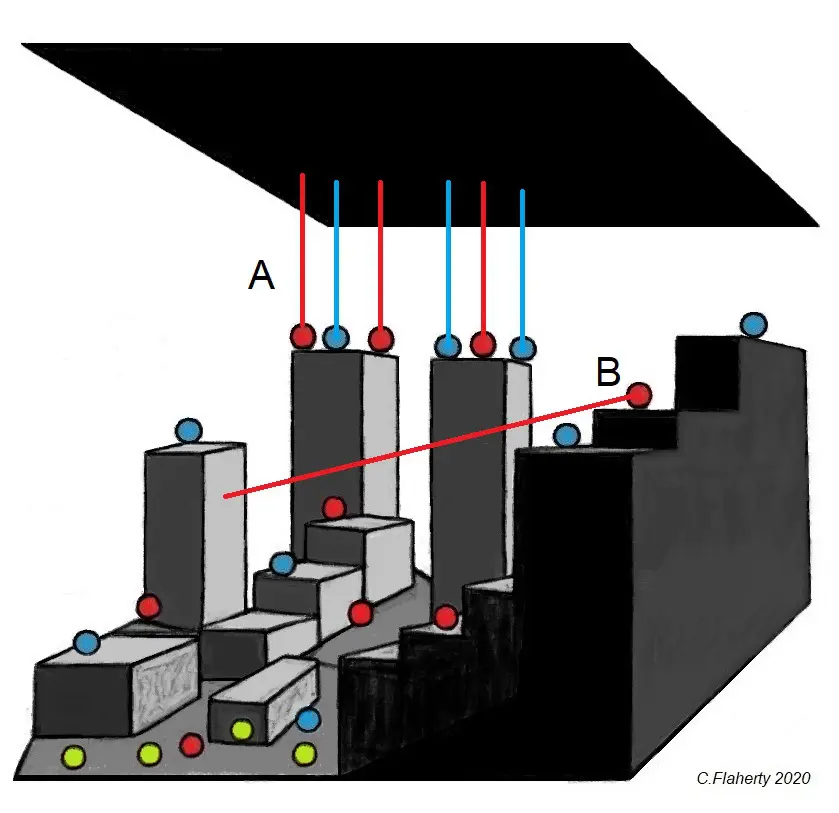
“FIGURE 4: A number of Laser Weapon Devices spread throughout an urban landscape operating off the Common Shared Platform and performing a number of tactical function-tasks: (A) Setting-up a Laser Screen; (B) Attacking Targets within the city.”
FIGURE 4: Shows a scenario where fast-to-plug-in Laser Weapon Devices, are saturated through-out an urban space. Two possible scenarios can be envisaged:
A. Some of the Laser Weapon Devices could foreseeably operate as a vertical killing zone – a Screen, providing the first line of defence.
B. A Laser Weapon Device detects movement in an adjacent building and fires at a Target.
Thousands of networked (and controlled), or lone-operating (initiated by movement, and sound sensors) fast-to-plug-in Laser Weapon Devices, could potentially be saturated through-out vast urban spaces. Drawing power needs from the Common Shared Platform (discussed earlier).
Laser Weapon Devices firing vertically, and criss-crossing every open and enclosed space could potentially be linked to locally captured security and CCTV cameras, to detect movement and trap potential Targets more easily. Reserve battery powered, for continuing functioning if the main power grid is shut down, could see opposing forces literally trapped, unable to be extracted or supported and being systematically dazzled, blinded and cut-to-pieces by Lasers.
PERIPHERAL MARAUDER BATTLE
As stated at the beginning of this paper, a future battle is likely to have three intermeshing components. The Epicentre Battle fought on the Terrestrial Surface, is anticipated to see a transition from conventional kinetic weapons to Laser Weapon Devices. Assumed to be a more defensive style of battle, this will be juxtaposed with Space-Based War; and, Peripheral Marauder Battle. Factors determining the shape of future battle are the increasing effectiveness of devolved forces, their mobility, and decision-control with greater reliance on Space-Based Infrastructure to direct forces on a planetary scale.
The term – Epicentre Battle, is part of a largely new language of strategic-tactical thinking replacing the notion of a Theatre of Operations. It is a recognition of the extreme expansion of such Theatres, due to mobility, speed, and height, seeing the air ceiling for flying craft reaching the interface of Low Earth Orbit Space and the Earth’s Atmosphere. This also includes development of Exo-Atmospheric Missile: Kinetic Kill Vehicle, that can attack targets both inside and outside the Earth’s Atmosphere.
The new Theatre is largely defined by the increasing range, accuracy and lethality of current (and future) generation very-long-range Air-to-Air Missiles. Currently, effective at over 185.2 kilometres: 100 nautical miles, this will push-out potential Theatre boundaries. Refuelling aircraft become more vulnerable to marauding enemy aircraft, operating sweeps of 926 kilometres: 500 to 1,389 kilometres: 750 nautical miles from their territory, potentially pushing the Theatre boundary by upwards of 1,852 kilometres: 1,000 nautical miles (Stillion, 2015). Future aerial combat is also expected to be marked by highly effective sensor-shoot capabilities, so rather than concentrate forces:
“future … aircraft may need to provide wide-area surveillance for themselves by operating as a large ‘distributed weapon system’ with sensors, weapons … [and their Command and Control]… linked by robust line-of-sight communication … air forces in the early … [21st Century] … may find advances in sensor, weapon, and network technology make it unnecessary to ‘concentrate’ their aircraft to achieve mutual support.” (Stillion, 2015)
The Peripheral Marauder Battle will not be limited to independently operating flying craft seeking-out and destroying the opponent’s logistical support, but will likely range on a planetary-scale. Strategic strikes with Hypersonic and Space-Based Weapons on ground launch, satellite control and communication facilities, and ground-links will likely arise as a necessity to cripple an opponent’s access to their Space-Based Infrastructure and Weapons.
Marauding on the periphery of the Epicentre Battle will also be an outcome of the unique strategic problem faced by all countries collectively, that competition and conflict occurs over a Common Shared Platform spread globally and into Space, that is more or less digital (dedicated to operating the Internet), and shared in common with potential rivals. Strategic advantage is defined by one side effectively co-opting much of the Common Shared Platform. In which case, the Peripheral Marauder Battle will likely take many forms globally in order to deny access, and take control. Leading to a situation, where apparently local and regional conflicts, will automatically become global in effect. Its consequences, will be much like the COVID-19 pandemic beginning in one country, leading to a domino set of problems, as trade, migration, and transnational economic activity became rapidly impacted, supply-linkages disrupted, production shut-down and shortages began to emerge.
REFERENCES
- Commander, U.S. Pacific Fleet. 2020 USS Portland Conducts Laser Weapon System Demonstrator Test. U.S. Navy Website (22 May).
- Department of Defense [U.S. Government]. Office of the Secretary of Defense. Technology Panel on DEW.
- Dukowitz, Z. 2017 Out of This World Anti-Drone Technology: Lasers, UTMs, Bullets with Nets, and More. UAV Coach Website (26 July).
- Ellis, J. 2015 Directed-Energy Weapons: Promise and Prospects. Center for a New American Security.
- Freedberg, S.J. 2020 A Golden Age For Collaboration On Lasers & Microwaves: But Watch The Cheetos! Breaking Defense Website (7 July).
- Hendrickx, B. 2020 Peresvet: A Russian Mobile Laser System to Dazzle Enemy Satellites. The Space Review Website (15 June).
- Keller, J. 2020 Here Comes the Army’s First Laser Battalion. Task and Purpose Website (6 August).
- Knorr, W. 1983 The Geometry of Burning-Mirrors in Antiquity. ISIS. Volume 74, Number 1 (March).
- Laporta, J. 2018 Navy Orders Laser Weapon Systems from Lockheed Martin. UPI Website: Space Daily (29 January).
- LASTEC [Laser Science & Technology Centre], 2020. Laser Fence System (LFS). LASTEC Website.
- Parigi, F.G. 1600 Wall Painting Showing the Archimedes mirror Burning Roman Ships. Uffizi Gallery, Stanzino delle Matematiche [Little Room of Mathematics]. Florence, Italy.
- Preston, R. Johnson, D.J. Edwards, S.J.A. Miller, M.D. Shipbaugh, C. 2002 Space Weapons, Earth Wars. RAND Corporation.
- Rogoway, T. 2020 How The Once Elusive Dream of Laser Weapons Suddenly Became a Reality. The War Zone Website (25 November).
- Speier, R.H. Nacouzi, G. Lee, C. Moore, R.M. 2017 Hypersonic Missile Nonproliferation: Hindering the Spread of a New Class of Weapons. RAND Corporation.
- Spencer, M. 2020 Directed Energy Weapons: Playing with Quantum Fire. Air Power Development Centre. Commonwealth of Australia (January).
- Stillion, J. 2015 Trends in Air-To-Air Combat: Implications For Future Air Superiority. Center for Strategic and Budgetary Assessments.
- Tatum, J. 2017 HPM DEWs and Their Effects on Electronic Targets. Defense Systems Information Analysis Center. Summer: Volume 4, Number 3.
- Team Crane. 2012 UAV Swarm Attack: Protection System Alternatives For Destroyers. Naval Postgraduate School. Capstone Project Report (December).
- Tzetzes, J. (Berkowitz, G. Translator) Chiliades [Book of Histories]. Book 2.3 Archimedes.
- United Nations. 2018 Revision of World Urbanization Prospects. Department of Economic and Social Affairs.
- S. Army Materiel Command. 1992 AMC-SSWMO Countermeasures Study. Volume 1: Guide To How Countermeasures Affect Smart Weapons.
- Vetrovec, J. 2002 Solid-State Laser High-Energy Laser. The Boeing Company.
- World Bank. 2020 United Nations Population Division. World Urbanization Prospects: 2018 Revision.
AUTHOR
Chris Flaherty authored the Terrorism Research Center’s report – Dangerous Minds (2012). He was the co-primary author, along with Robert J. Bunker of the book – Body Cavity Bombers: The New Martyrs (iUniverse, 2013). Two essays of his, from 2003 and 2010 were reprinted in the Terrorism Research Center’s book – Fifth Dimensional Operations (iUniverse, 2014). He recently contributed a book chapter – The Role of CCTV in Terrorist TTPs, edited by Dave Dilegge, Robert J. Bunker, John P. Sullivan, and Alma Keshavarz, the book – Blood and Concrete: 21st Century Conflict in Urban Centers and Megacities, a Small Wars Journal anthology, published on behalf of the Small Wars Foundation with Xlibris (2019).
Dr Chris Flaherty https://au.linkedin.com/in/drchrisflaherty

